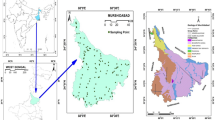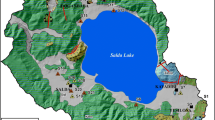Abstract
In this study, the physicochemical parameters, major ions and arsenic (As) contents of water resources in the Yazır lake wetland, were evaluated. In addition, water resources in this region were investigated from the point of water quality and health risk assessment. Thirty water samples were collected from the area in dry and wet seasons. Ca-Mg-HCO3 and Ca-HCO3 were the dominant water types. The Gibbs diagram suggests that most of the samples fall in rock-dominance zone, which indicates the groundwater interaction between rock chemistry. When compared to drinking water guidelines established by World Health Organization and Turkey, much greater attention should be paid to As, Fe, and Mn through varied chemicals above the critical values. According to the pH-ORP diagram, the predominant species is arsenate (H2AsO4−2). The high concentrations of As in the surface water and groundwater are related to oxidative and reductive dissolution reaction of Fe and Mn hydroxides within the Kızılcadağ ophiolite and melange. In addition, the seasonal changes in As concentrations depend on the increase in pH of water samples. The major toxic and carcinogenic chemical within water samples is As for groundwater and surface water. From the results of hazard index, it is verified that As which is taken by ingestion of water was the main contaminant, and toxic human risk in the study area. The obtained results will help define strategies for As problems in the water resources in future.








Similar content being viewed by others
References
Alam MO, Shaikh WA, Chakraborty S, Avishek K, Bhattacharya T (2016) Groundwater arsenic contamination and potential health risk assessment of Gangetic Plains of Jharkhand, India. Expo Health 8(1):125–142
APHA (1998) Standard Methods for the Examination of Water and Wastewater, 20th Edn. American Public Health Association, American Water Works Association and Water Environmental Federation, Washington DC
ATSDR (2000) Toxicological profile for arsenic. Atlanta, Georgia, Agency for Toxic Substances and Disease Registry, U.S. Department of Health & Human Services. TP-92/02
Bilgin ZR, Karaman T, Öztürk Z, Şen MA, Şenel M (1990) Geological report of the around Yesilova-Acigol, mineral research & exploration general directorate report 9071, Ankara-Turkey
Çapan U (1980) Toros Kuşağı Ofiyolit Masiflerinin(Marmaris, Mersin, Pozantı, Pınarbaşı ve Divriği) İç Yapıları, Petrolojisi ve Petrokimyalarına Yaklaşımlar. Hacettepe Üniv. Fen Bil. Enst. Doktora Tezi, 400s., Ankara
Casiot C, Morin G, Juillot F, Bruneel O, Personne JC, Leblanc M (2003) Bacterial immobilization and oxidation of arsenic in acid mine drainage (Carnoules creek France). Water Resour 37:2929–2936
Cho KH, Sthiannopkao S, Pachepsky YA, Kim KW, Kim JH (2011) Prediction of contamination potential of groundwater arsenic in Cambodia, Laos, and Thailand using artificial neural network. Water Res 45:5535–5544
Davraz A, Özdemir A (2014) Groundwater quality assessment and its suitability in Çeltikçi plain (Burdur/Turkey). Environ Earth Sci 72:1167–1190
Erakman B, Meşhur M, Gül MA, Alkan H, Öztaş Y and Akpınar M (1982) Report of the geology and hydrocarbon potential of the Kalkan-Köyceğiz-Çameli-Tefenni area depending on the Taurus project. Turkey Petroleum Corporation (TPC) Rep: 1732
Gasemi A, Razmara M, Nazari E, Nematollahi MJ, Borabadi R (2014) Hydrological and geochemical processes controlling the origin and transport of arsenic in the Pangi area (NW Torbat Hydarieh, Iran). J Middle East Appl Sci Technol (JMEAST) 15(2):29–34
Gibbs RJ (1970) Mechanisms controlling worlds water chemistry. Science 170:1088–1090
Gnanachandrasamy G, Ramkumar T, Venkatramanan S, Vasudevan S, Chung SY, Bagyaraj M (2015) Accessing groundwater quality in lower part of Nagapattinam district, southern India: using hydrogeochemistry and GIS interpolation techniques. Appl Water Sci 5:39–55
Hem J (1985) Study and interpretation of the chemical characteristics of natural water, U.S. Geological Survey Water-supply Paper 2254. USGS, Reston, p 264
Jamaludin N, Sham SM, Ismail SNS (2013). Health risk assessment of nitrate exposure in well water of residents in intensive agriculture area. Am J Appl Sci 10(5):442
Jeong CH (2001) Effect of land use and urbanization on hydrochemistry and contamination of groundwater from Taejon area, Korea. J Hydrol 253:194–210
Kavcar P, Sofuoglu A, Sofuoglu S (2009) A health risk assessment for exposure to trace metals via drinking water ingestion pathway. Int J Hyg Environ Health 212:216–227
Kelepertsis A (2000) Applied geochemistry (in Greek). Mache donian press, Athens, p 37
Khan S, Cao Q, Zheng YM, Huang YZ, Zhu YG (2008) Health risk of heavy metals in contaminated soils and food crops irrigated with wastewater in Beijing China. Environ Pollut 152:686–692
Koçyiğit A, Ünay E, Saraç G (2000) Episodic graben formation and extensional neotectonic regime in west central Anatolia and the Isparta angle: a case study in the Akşehir-Afyon graben, Turkey. Geol Soc Lond Spec Pbl 173:405–421
Köse İ (2017) Hydrogeological and hydrogeochemical investigations of Yazır Lake (Çavdır/Burdur) Wetlands Basin, Suleyman Demirel University, Institute of Science and Technology, master's thesis, 117 pages, Isparta/Turkey (Turkish)
Kumar SK, Babu SH, Rao PE, Selvakumar S, Thivya C, Muralidharan S, Jeyabal G (2016) Evaluation of water quality and hydrogeochemistry of surface and groundwater, Tiruvallur District, Tamil Nadu, India. Appl Water Sci 7:2533–2544. https://doi.org/10.1007/s13201-016-0447-7
Makwe E, Chup CD (2013) seasonal variation in physico-chemıcal propertıes of groundwater around Karu Abattoır. Ethiop J Environ Stud Manag 6(5):489–497
Manish K, Ramanathan A, Rao MS, Kumar B (2006) Identification and evaluation of hydrogeochemical processes in the groundwater environment of Delhi, India. J Environ Geol 50:1025–1039
Manning B, Goldberg S (1997) Arsenic (III) and arsenic (IV) adsorption on three California soils. Soil Sci 162:121–131
McArthur JM, Ravenscroft P, Safiulla S, Thirlwall MF (2001). Arsenic in groundwater: testing pollution mechanisms for sedimentary aquifers in Bangladesh. Water Resour Res 37(1):109-117
Meşhur M, Yoldemir O, Akpınar M, Öztaş I and Alkan H (1989). Report of geology and oil possibilities of the Western Taurus. Turkey Petroleum Corporation (TPAO) Rep. (unpublished), Ankara-Turkey
Muhammad S, Shah MT, Khan S (2010) Arsenic health risk assessment in drinking water and source apportionment using multivariate statistical techniques in Kohistan region, northern Pakistan. Food Chem Toxicol 48:2855–2864
Nagarajan R, Rajmohan N,·Mahendran U, Senthamilkumar S (2010) Evaluation of groundwater quality and its suitability for drinking and agricultural use in Thanjavur city, Tamil Nadu, India, Environ Monit Assess, 171:289–308
Ngabirano H, Byamugisha D, Ntambi E (2016) Effects of seasonal variations in physical parameters on quality of gravity flow water in Kyanamira Sub-County, Kabale District, Uganda. J Water Resour Protect 2016(8):1297–1309
Nguyen VA, Bang S, Viet PH, Kim KW (2009) Contamination of groundwater and risk assessment for arsenic exposure in Ha Nam province, Vietnam. Environ Int 35(2009):466–472
Nickson R, McArthur J, Burgess W, Ahmed KM, Ravenscroft P, Rahmanñ M (1998). Arsenic poisoning of Bangladesh groundwater. Nature 395(6700):338
Oinam JD, Ramanathan AL, Linda A, Singh G (2011) A study of arsenic, iron and other dissolved ion variations in the groundwater of Bishnupur District, Manipur. India. Environ Earth Sci 62:1183–1195
Olı’as M, Nietob JM, Sarmiento AM, Cero’n JC, Ca’novas CR (2004) Seasonal water quality variations in a river affected by acid mine drainage: the Odiel River (south West Spain). Sci Total Environ 333:267–281
Piper AM (1944) A graphic procedure in the chemical interpretation of water analysis. Am Geophys Union Trans 25:914–923
Piper AM (1953) A graphical procedure in the geochemical interpretation of water analysis. Trans Am Geophys Union 2(5):914–928
Poisson A (1977) Recherces Geologiques Dans Les Taurides Occidentales (Turquie). These Univ, Paris-Sud 795 p
Qaiyum MS, Shaharudin MS, Syazwan AI, Muhaimin A (2011) Health risk assessment after exposure to aluminium in drinking water between two different villages. J Water Resour Prot 3(04):268
Ranjan RK, Ramanathan AL, Parthasarthy P, Kumar A (2013) Hydrochemical characteristics of groundwater in the plains of Phalgu river in Gaya, Bihar, India. Arab J Geosci 6:3257–3267
Rasool A, Farooqi A, Masood S, Hussain K (2016) Arsenic in groundwater and its health risk assessment in drinking water of Mailsi, Punjab, Pakistan. Hum Ecol Risk Assess: Int J 22(1):187202
Şenel M, Selçuk H, Bilgin ZR, Şen AM, Karaman T, Dinçer MA, Durukan E, Arbas A, Örçen S and Bilgi C (1989) Geology of The C ¸ ameli (Denizli)—Yesilova (Burdur)—Elmalı (Antalya) and The Northern Part. Mineral Research & Exploration General Directorate Rep: 9429 (unpublished), Ankara-Turkey
Siegel RF (2002) Environmental geochemistry of potentially toxic metals. Springer, Berlin, p 218
Smedley PL, Kinniburgh DG (2002) A review of the source, behaviour and distribution of arsenic in natural waters. Appl Geochem 17:517–568
Smedley PL and Kinniburgh DG (2013) Chapter 12: arsenic in groundwater and the environment. In: Essentials of medical geology, second edition. Eds: Selinus, O., Alloway, B., Centeno, J.A., Finkelman, R.B., Fuge, R., Lindh, U. And Smedley, P.L. Springer, pp 279–310
Stamatis G (2010) Ground water quality of the ag. Paraskevi tempi valley karstic springs application of a tracing test for research of the micro-bial pollution (KatoOlympos/NE Thessaly). Bull Geol Soc Greece 43:1868–1877
Subramani T, Elango L, Damodarasamy SR (2005) Groundwater quality and its suitability for drinking and agricultural use chithar River Basin, Tamil Nadu, India. Environ Geol 47:1099–1110
Sullivan JP, Agardy JF, Clark JJ (2005) The environmental science of drinking water. Elsevier Butterworth-Heinemann, Oxford 384
Teker Y (2010) the manganese Occurences of Isparta and Burdur compared with different manganese origin types of Turkey by geological, Mineralogıcal and geochemical properties, Suleyman Demirel university graduate School of Applied and Natural Sciences Department of geological engineering, 293 page, Isparta-Turkey (Turkish)
TSI (2005) Standards for drinking waters-266. Turkish Standards Institution, Ankara
TSI (2017) Turkish Istatistical Institute data, http://www.turkstat.gov.tr
USEPA (1989) Risk Assessment Guidance for Superfund, Vol. I. Human Health Evaluation Manual, EPA/540/1-89/002. Washington, DC
UNESCO (2007) UNESCO water portal newsletter no. 161: Water-related diseases. http://www.unesco.org/water/news/newsletter/161.shtml
US Environmental Protection Agency (USEPA) (1998) Arsenic, inorganic. United States Environmental Protection Agency, integrated risk information system (IRIS), (CASRN 7440-38-2). <http://www.epa.gov/iris/subst/0278.htm>
US Environmental Protection Agency (EPA) (2000) Water quality standards, Establishment of Numeric Criteria for Priority Toxic Pollutants for the State of California
US Environmental Protection Agency (USEPA) (2005) Guidelines for Carcinogen Risk Assessment. Risk Assessment Forum, Washington, DC, EPA/630/P-03/001F
Varol S, Davraz A (2015) Evaluation of the groundwater quality with WQI (water quality index) and multivariate analysis: a case study of the Tefenni plain (Burdur/Turkey). Environ Earth Sci 73:1725–1744
Varol S, Davraz A (2016) Evaluation of potential human health risk and investigation of drinking water quality in Isparta city center (Turkey). J Water Health 14(3):471–488
Venkatramanan S, Chung SY, Ramkumar T, Gnanachandrasamy G, Vasudevan S, Lee SY (2015) Application of GIS and hydrogeochemistry of groundwater pollution status of Nagapattinam district of Tamil Nadu, India. Environ Earth Science 73:4429–4442
Welch AH, Westjohn DB, Helsel DR, Wanty RB (2000). Arsenic in ground water of the United States: occurrence and geochemistry. Groundwater 38(4):589-604.
Williams M (2001) Arsenic in mine waters: an international study. Environ Geol 40:267–278
WHO (2008) Guidelines for drinking‐water quality [electronic resource]: incorporating 1st and 2nd addenda, vol 1. Recommendations, 3rd edn. WHO Library Cataloguing‐in‐Publication Data, Geneva
World Health Organization (WHO) (2004) Guidelines for drinking water quality, second ed., Geneva
World Health Organization (WHO) (2011) Guidelines for drinking-waterquality, 4th edn. World Health Organization, Geneva
Acknowledgments
This work was supported by the Research Fund of the Suleyman Demirel University, project number 4455-YL1-15. The support of the General Directorate of State Hydraulic Works (SHW) XVIII Regional Directorate, Isparta, is gratefully acknowledged.
Author information
Authors and Affiliations
Corresponding author
Additional information
Responsible editor: Philippe Garrigues
Rights and permissions
About this article
Cite this article
Varol, S., Köse, İ. Effect on human health of the arsenic pollution and hydrogeochemistry of the Yazır Lake wetland (Çavdır-Burdur/Turkey). Environ Sci Pollut Res 25, 16217–16235 (2018). https://doi.org/10.1007/s11356-018-1815-7
Received:
Accepted:
Published:
Issue Date:
DOI: https://doi.org/10.1007/s11356-018-1815-7




